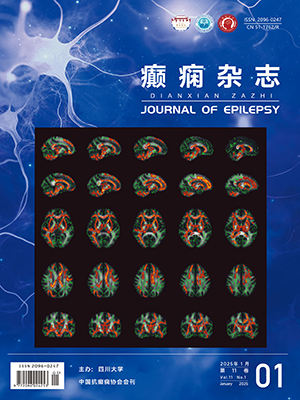| 1. |
Gledhill RF. In the shadow of epilepsy. The Lancet, 1997, 350(9080): 811.
|
| 2. |
Ngugi AK, Bottomley C, Kleinschmidt I, et al. Estimation of the burden of active and life-time epilepsy: a meta-ana-lyticapproach. Epilepsia, 2010, 51(5): 883-890.
|
| 3. |
Hauser WA. Recent developments in the epidemiology of epilepsy. Acta Neurol Scand, 1995, 162(92): 17-21.
|
| 4. |
Knudsen FU. Febrile seizures: treatment and prognosis. Epilepsia, 2000, 41(1): 2-9.
|
| 5. |
Verity CM, Greenwood R, Golding J. Long-term intellectual and behavioral outcomes of children with febrile convulsions. N Engl J Med, 1998, 338(24): 1723-1728.
|
| 6. |
Beghi E, Giussani G, Nichols E, et al. Global, regional, and national burden of epilepsy, 1990–2016: a systematic analysis for the Global Burden of Disease Study 2016. Lancet Neurol, 2019, 18(4): 357-375.
|
| 7. |
Hauser WA. Seizure disorders: the changes with age. Epilepsia, 1992, 33(Suppl 4): 6-14.
|
| 8. |
Cowan LD. The epidemiology of the epilepsies in children. Ment Retard Dev Disabil Res Rev, 2002, 8(3): 171-181.
|
| 9. |
Eisner V, Pauli LL, Livingston S. Epilepsy in the families of epileptics. The Journal of Pediatrics, 1960, 56(3): 347-354.
|
| 10. |
Thom, DA, Walker GS. Epilepsy in the offspring of epileptics. The American Journal of Psychiatry, 1992, 78(4): 613-627.
|
| 11. |
Annergers JF, Hauser WA, Anderson VE, et al. The risk of seizure disorders among relatives of patients with childhood onset epilepsy. Neurology, 1982, 32(2): 174-179.
|
| 12. |
Hauser WA, Annegers JF, Kurland LT. Incidence of epilepsy and unprovoked seizures in Rochester, Minnesota: 1935–1984. Epilepsia, 1993, 34(3): 453-468.
|
| 13. |
Sidenvall R, Heijbel J, Blomquist HK, et al. An incident case-control study of first unprovoked a febrile seizures in children: a population-based study of pre-and perinatal risk factors. Epilepsia, 2001, 42(10): 1261-1265.
|
| 14. |
Jennett B. Trauma as a cause of epilepsy in childhood. Dev Med Child Neurol, 1973, 15(1): 56-62.
|
| 15. |
Bergamasco B, Benna P, Ferrero P, et al. Neonatal hypoxia and epileptic risk: a clinical prospective study. Epilepsia, 1984, 25(2): 131-136.
|
| 16. |
Braathen G, Theorell K. A general hospital population of childhood epilepsy. Acta Paediatr, 1995, 84(10): 1143-1146.
|
| 17. |
Vera, Ehrenstein, Lars, et al. Postterm delivery and risk for epilepsy in childhood. Pediatrics, 2007, 119(3): e554-e561.
|
| 18. |
Altunbasak S, Herguner O, Burgut HR. Risk factors predicting refractoriness in epileptic children with partial seizures. Journal of Child Neurology, 2007, 22(2): 195-199.
|
| 19. |
Burton KJ, Rogathe J, Whittaker R, et al. Epilepsy in Tanzanian children: Association with perinatal events and other risk factors. Epilepsia, 2012, 53(4): 752-760.
|
| 20. |
Masri A, Ba Dran E, Hamamy H, et al. Etiologies, outcomes, and risk factors for epilepsy in infants: A case–control study. Clin Neurol Neurosurg, 2008, 110(4): 352-356.
|
| 21. |
Cansu A, Serdarolu A, Deniz Yüksel, et al. Prevalence of some risk factors in children with epilepsy compared to their controls. Seizure, 2007, 16(4): 338-344.
|
| 22. |
Habbal AA, Alsharif A, Almubark A, et al. Risk factors associated with epilepsy in children and adolescents: a case-control study from Syria. Epilepsy & Behavior, 2021, 114(4): 264-271.
|
| 23. |
Daoud AS, Batieha A, Bashtawi M, et al. Risk factors for childhood epilepsy: a case-control study from Irbid, Jordan. Seizure, 2003, 12(3): 171-174.
|
| 24. |
Asadi-Pooya AA, Hojabri K. Risk factors for childhood epilepsy: a case-control study. Epilepsy & Behavio, 2005, 6(2): 203-206.
|
| 25. |
Thomas VA, Anil S, Vivek OV. Risk factors of childhood epilepsy in Kerala. Ann Indian Acad Neurol, 2011, 14(4): 283-286.
|
| 26. |
兰州军区协作组. 西北五省区儿童癫痫危险因素研究: 附187例对照分析, 临床儿科杂志, 1990, 8(4): 216-218.
|
| 27. |
章素芳, 程鹏. 癫痫患儿发病的危险因素的分析, 中国当代医药, 2017, 24(17): 83-85.
|
| 28. |
康庆云, 廖红梅, 杨赛, 等. 离子通道基因突变相关儿童癫痫性脑病33例临床特征和基因突变分析. 神经损伤与功能重建, 2021, 16(12): 774-776.
|
| 29. |
Covanis A. Epileptic encephalopathies(including severe epilepsy syndromes). Epilepsia, 2012, 53(s4): 114-126.
|
| 30. |
王蕾. 全面护理方式对小儿癫痫护理工作的影响探究, 实用临床护理学电子杂志, 2020, 5(2): 121-129.
|
| 31. |
富建华, 张丹. 围产期感染对子代近远期中枢神经系统的影响, 中国实用妇科与产科杂志, 2016, 32(6): 4.
|
| 32. |
Edwards T, Scott AG, Munyoki G, et al. Active convulsive epilepsy in a rural district of Kenya: a study of prevalence and possible risk factors. Lancet Neurology, 2008, 7(1): 50-56.
|
| 33. |
Record EJ, Bumbut A, Shih S, et al. Risk factors, etiologies, and comorbidities in urban pediatric epilepsy. Epilepsy & Behavior, 2021, 115: 107716.
|
| 34. |
中华医学会儿科学分会神经学组. 热性惊厥诊断治疗与管理专家共识(2017年实用版). 中华实用儿科临床杂志, 2017, 32(18): 149-153.
|
| 35. |
Seshia SS, Huntsman RJ, Lowry NJ, et al. Neonatal seizures: diagnosisand mana Gement. Chin J Contemp Pediatr, 2019, 13(2): 81-100.
|
| 36. |
胡蜀湘, 廖卫平. 中枢神经系统感染与癫痫, 临床荟萃, 2004, 19(21): 1206-1209.
|
| 37. |
Nicolosi A, Hauser WA, Beghi E, et al. Epidemiology of central nervous system infections in Olmsted County, Minne-sota, 1950-1981. J Infect Dis, 1986, 154(3): 399-408.
|
| 38. |
Annegers JF, Hauser WA, Beghi E, et al. The risk of unprovoked seizures after encephalitis and meningitis. Neurology, 1988, 38(9): 1407-1410.
|




